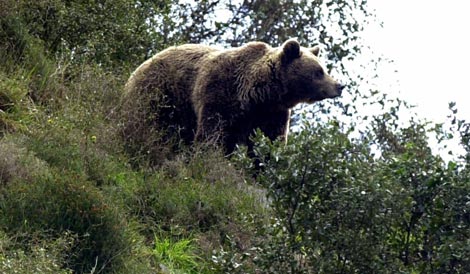Archive for the ‘Cantabrian mountains’ Category
Brown bear population in Spain 2013
Tuesday, October 22nd, 2013Bear in camera trap
Monday, July 22nd, 2013
Fantastic photo taken by a camera trap somewhere in Asturias by the wildlife group FAPAS.
Summer love
Friday, September 30th, 2011Lisa over at picosdeeuropa.com has an interesting account of how at least one pair of Cantabrian bears has bred later in the year, in late August, instead of May-June, presumably because of climate change. More here
Interview with Roberto Hartasánchez
Thursday, January 28th, 2010Interview with Roberto Hartasánchez, the president of FAPAS on Spanish National radio. An interesting ten minute overview of bears, the serious impact of the disappearance of bees, and the state of conservation of the Cantabrian Mountains in general. Listen here.
Good news from Palencia
Saturday, December 5th, 2009
A “new” reproductive female bear with two cubs has been found in Palencia, part of the beleaguered Eastern Cantabrian bear population. With only 30 odd individuals, this population is in a critical state, with at the last count, only two breeding females. In 2008 three cubs were born to the two females only one of which survived, one having been lost to infanticide and the other dying from unknown causes. This discovery of a third female and her two cubs of this year is raises hope for the bears’ future in this region. From Lisa on PicosdeEuropa and originally from nortecastilla.es. (above photo with bear and cubs). This autumn have may been a good one for Cantabrian bears thanks to the mild conditions and plentiful fruit.
Picos de Europa online
Thursday, November 26th, 2009My friend Lisa who used to write the bear news on iberianature has finally brought on line her long-awaited Picos de Europa guide. This looks likely to become the English-language guide to those stunning mountains. There’s lots of interesting nature stuff on the web including Poison, Palencia and Picos and Return of the Lammergeier.
The Great Mountain Corridor
Thursday, November 26th, 2009
The Great Mountain Corridor is an idea to create a vast ecological corridor connecting the Cantabrian Mountains, the Pyrenees and the Alps, and possibly eventually, the Balkans, along which wolves, bears and other animals could roam relatively unhindered.
The GMC is a 1300-kilometre swathe of land connecting the Cantabrian mountains in Spain to the Italian Alps via the Pyrenees and Massif Central in France. It might even be extended into the Carpathian mountains of eastern Europe. “It’s not unrealistic to think that in 20 years there could be a good corridor between the Iberian Peninsula and the Balkans,” says Miquel Rafa of Obra Social Caixa Catalunya in Barcelona, Spain, a charitable organisation that is promoting the project. Some of the land in the proposed corridor is already protected, and Rafa’s aim is to fill in the gaps. Over the past decade, his organisation has spent 8 million euro buying 80 square kilometres of land between the Cantabrians and the Pyrenees. He estimates that only another 80 square kilometres is needed to complete that part of the corridor. There are already success stories to report. Last year, a wolf from the Cantabrian mountains was spotted in the Pyrenees, not far from one of many packs that arrived there from the French Alps around 10 years ago – the first wolves in the Pyrenees since the 1930s. These packs made a hazardous crossing of the Rhone valley, parts of which are industrialised. It will be remarkable if groups from the Cantabrians and French Alps meet and breed in the Pyrenees, says Rafa, as the populations have been separated for over 800 years. To win local support, Rafa and colleagues have also provided shepherds with Pyrenean mountain dogs, a muscular breed that will defend livestock against wolves. More here from New Scientist article nabbed here “Megaconservation: Saving wildernesses on a giant scale”
See also Territori i Paisatge here
Cantabrian bear groups rejoined
Tuesday, August 18th, 2009Great news from biologists at Oviedo University; they now have positive DNA tested proof that two young bears are the progeny of a female bear from the east and a male from the west. Two hair/faeces samples taken in Redes Natural Park (Asturias) in November last year found two siblings, one male and of one unidentified sex. Another sample taken this spring in the Picos de Europa National Park has confirmed the analysis. More on this soon. Europa Press
- Above map from Wikipedia
Many thanks to Lisa on the forum for letting me know about this news, which is key to guaranteeing genetic diversity for Cantabrian bears, whose twin populations were separated more than 60 years ago.
Increase in brown bear population
Monday, July 27th, 2009
Good news – in part. The population of brown bears in the Cantabrian Mountains continues to grow. According to the latest bear census, a total of 19 female bears raised 37 cubs last year. The census was carried out in Asturias, Cantabria and Castilla y León by the Fundación Oso Pardo. However, the situation in the eastern populations of bears straddling Cantabria and Castilla y León continues to be “worrying”. Of the 37 cubs raised, just three cubs were raised in this area. The rest were raised by bears in the far healthier western population. El Mundo
In demonstration of the improved situation of bears in the western area, the World Conservation Union has just reduced the classification of the bears in this area from “Critically endangered” to “Endangered”. La Nueva España
Cantabrian nature blog
Wednesday, July 15th, 2009
One of my favourite Spanish nature blogs is Zona Osera (Bear Zone) written by Hector Ruiz from the Valle de Laciana, León. Superb photography and great natural history writing.
